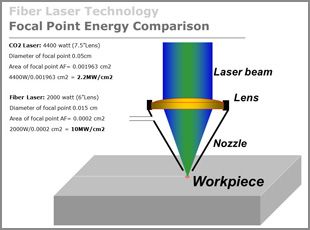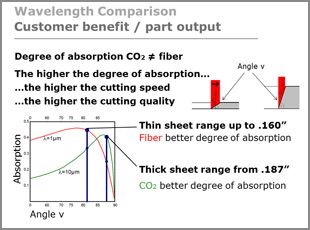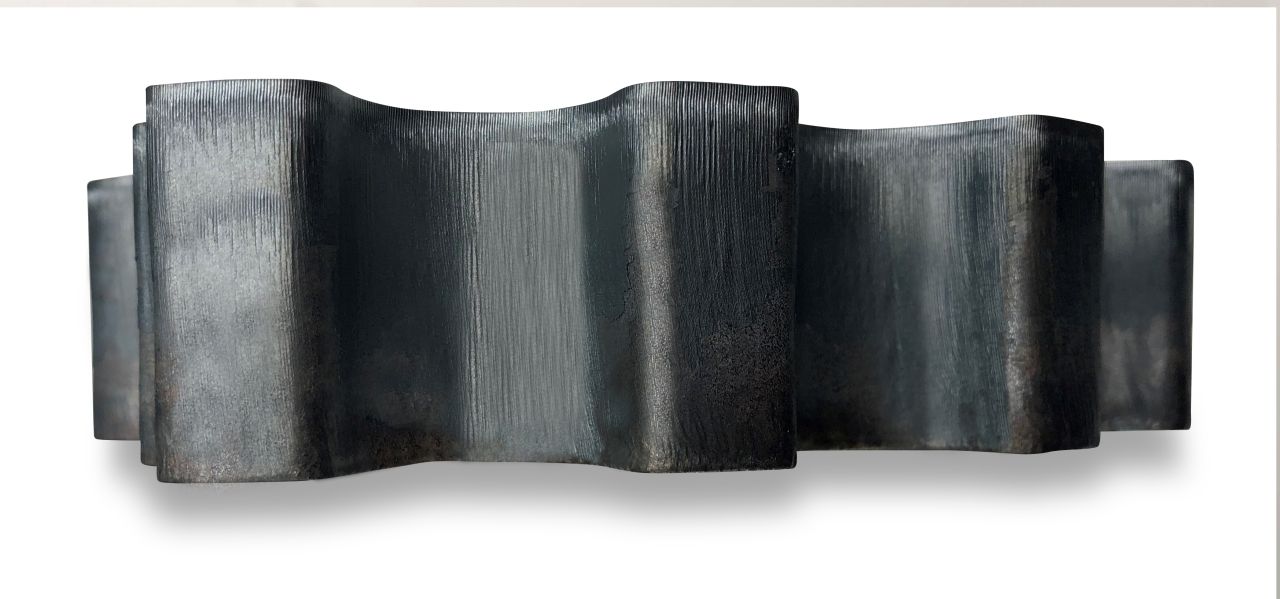CO₂ vs. Fiber Laser Technology: Which is right for you?
Evolution of Fiber Laser Cutting Technology
This careful and comprehensive analysis examines not only the cutting equipment but also the impact the new equipment will have on other existing sheet metal fabricating processes.
Fiber laser cutting has been one of the most “disruptive” technologies introduced to the metalworking market since CO₂ lasers were first introduced for cutting in the 1980s. Fiber laser technology is considered a disruptive and “revolutionary” change because it has impacted the entire status quo in sheet metal fabrication. And the opportunities are easy to realize.
Over a relatively short period of time, we have seen exponential advances in fiber laser technology used for flat sheet metal cutting. In just five years, fiber lasers achieved the 4kW cutting threshold that took CO₂ lasers approximately four times as long to reach. After ten years, fiber lasers have achieved the 20-30kW power levels for cutting. In all fairness, fiber lasers – some exceeding 20kW – have been used by other industries for many years in applications other than sheet metal cutting.
Advantages of Fiber Laser Cutting Technology
The primary advantages of cutting flat sheet metal with Fiber laser technology are derived from its monolithic, Fiber-to-Fiber, compact solid-state design configuration that is maintenance-free and provides a lower cost of operation than can be achieved with comparable CO₂ lasers. Fiber laser beam characteristics also provide for much faster cutting speeds than CO₂ as we will explore below.
The focused beam of even a 2kW fiber laser demonstrates a 5X greater power density at the focal point when compared with a 4kW CO₂ laser. It also possesses a 2.5X greater absorption characteristic due to the shorter wavelength of the fiber laser. (see Figure 1 and Figure 2).
The higher absorption of the fiber wavelength and the higher power density created by the focused beam combine to achieve up to a five-time increase in cutting speeds in materials that are less than 1/2 inch thick.
Fiber laser cutting systems can certainly cut more than one inch thick with higher Fiber laser powers and even cut faster when utilizing nitrogen as the assist gas, but the “sweet spot” where the most significant benefits are realized is in the 1/2 inch and under range for steel when making comparisons with CO₂ systems. For certain, if you are processing stainless, aluminum, brass, or copper materials, fiber laser technology is the fastest and most economical regardless of thickness.

Figure 1
Power density comparison of CO₂ and Fiber lasers at the focal point.

Figure 2
Absorption comparison between CO₂ and Fiber lasers based on wavelength and thickness.
The speed benefits are most profound when nitrogen is employed as an assist gas because the molten material is expelled from the kerf by the nitrogen just as fast as it is melted. The higher the laser beam power density, the quicker the material is brought to a molten state, the faster the feed rate.
Effectively utilizing the speed benefits from high-power fiber lasers takes careful planning and management of all processes. With a three to four-times greater throughput and a cost of operation that is half of the CO₂ laser, the financial gains can be game-changing. The results are a lower cost per part, higher potential profit margins, and shorter return on investment time. Let’s not forget the added benefit of increased machine capacity now that you are processing normal part volumes much faster, providing the opportunity to take on additional work to further increase your sales revenue and profits.
Fiber lasers can cut aluminum, copper, and brass more safely than CO₂ because the beam is redder and more readily absorbed and not reflected. Operating costs are typically half of what a CO₂ system can offer due to the lower electrical consumption and high electrical efficiency of fiber lasers.
One of the latest advancements in Fiber laser cutting is the addition of ‘Beam Shaping’ technology that changes the beam profile for thick plate cutting with Oxygen. Because the fiber laser is delivered through fiber optics, the beam profile is inherently small, creating a narrow channel as it focuses through the material. While this is advantageous to the power density for cutting with nitrogen as the assist gas, this is not the case with oxygen assist cutting. When cutting with oxygen, a wider beam profile with less power density is preferred as it creates a wider channel in the material by which to expel the molten steel. The wider beam profile produces faster cutting speeds, and increased cut edge quality on thicker steels. Beam Shaper technology achieves the wider beam profile necessary to achieve this increased performance.
There are many aspects of operating a CO₂ laser cutter that do not exist with operating a fiber laser cutter:
- A high-power Fiber laser cutter is capable of cutting up to 5 times faster than a conventional CO₂ laser and utilizes half the operating costs.
- Fiber laser cutters do not need any warm-up time – typically about 10 minutes per start-up for a CO₂ laser.
- The fiber laser cutter has no beam path maintenance such as mirror or lens cleaning, bellows checks, and beam alignments. This can consume another 4 or 5 hours per week for a CO₂ laser.
- Fiber lasers have a fully sealed fiber optic beam path both at the power source and at the Fiber delivery to the cutting head. The beam is not subjected to beam path contaminates as is the case with CO₂ lasers.
- Fiber optic beam paths maintain consistent nozzle beam centering.
Because the integrity of the fiber beam remains consistent from day to day, so do the cutting parameters, requiring fewer adjustments than a CO₂ laser.
What becomes of all of this saved time? Higher productivity and greater machine capacity! With the fiber laser capable of five times faster cutting speeds, generating three to four times more parts per unit of time and coupled with 50% less operating costs as compared to CO₂, this represents a large opportunity based on having created more machine capacity.
Whatever the conclusion, don’t forget about the impact of this investment on your downstream processes: What effect does adding this new laser cutting system have on the flow of operations before and after the parts are cut?
Certainly knowing and preparing in advance that front-end office systems will need to keep up with the productivity of the fiber laser helps fabricators adjust their front-end processes to keep the fiber laser cutting, rather than waiting for jobs. Knowing that materials will need to be presented to the fiber laser in a timely manner will drive new efficiency in material handling and inventory. Knowing that increased cut part volumes need to be met with additional bending capacity will help prepare the bending area for the increased volume. For fabricators using CO₂ laser cutting systems, making the move to fiber technology represents a huge window of opportunity that can’t be overlooked.
If you are running multiple lasers, perhaps you could consider replacing two CO₂ laser cutting machines with one fiber laser.
The question of which technology is right for you boils down to your operation. How well does the system fit your particular application? How much faster and how much more cost-effective are your parts going to be produced? With this in mind, it will be necessary to make a careful analysis of the pertinent data, including application range, operating costs, throughput, cost of ownership, and, of course, investment costs.
Note: Originally published July 2013. Revised January 2023.
About the Author
Frank Arteaga is Regional Director Marketing/CORCOM - Market Region Americas, Bystronic Inc.
About Bystronic Inc.
Bystronic is a worldwide supplier of high-quality laser cutting systems, press brakes, automation, and software for the economical processing of sheet metal and tubes. Bystronic stands for reliability, high-performance innovation, an outstanding price-performance ratio, and user-friendly operation. The focus is on the automation of the complete material and data flow of the sheet metal cutting and bending process chain. The company’s headquarters for the Americas is located in Hoffman Estates, IL. Offices are also located in Toronto, Canada, Monterrey, Mexico and Columbo, Brazil.
For more information on Bystronic Inc, contact by e-mail sales.us@bystronic.com.


